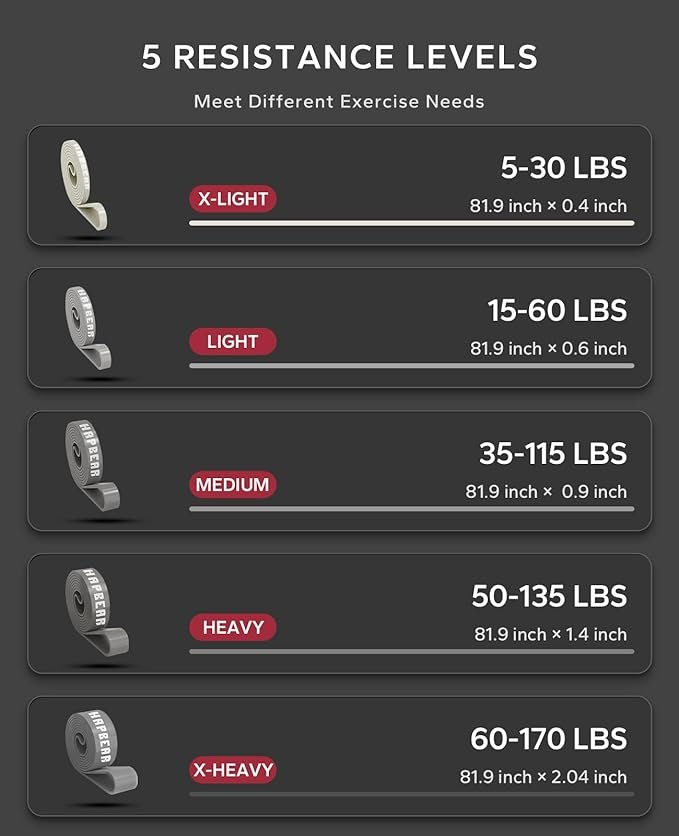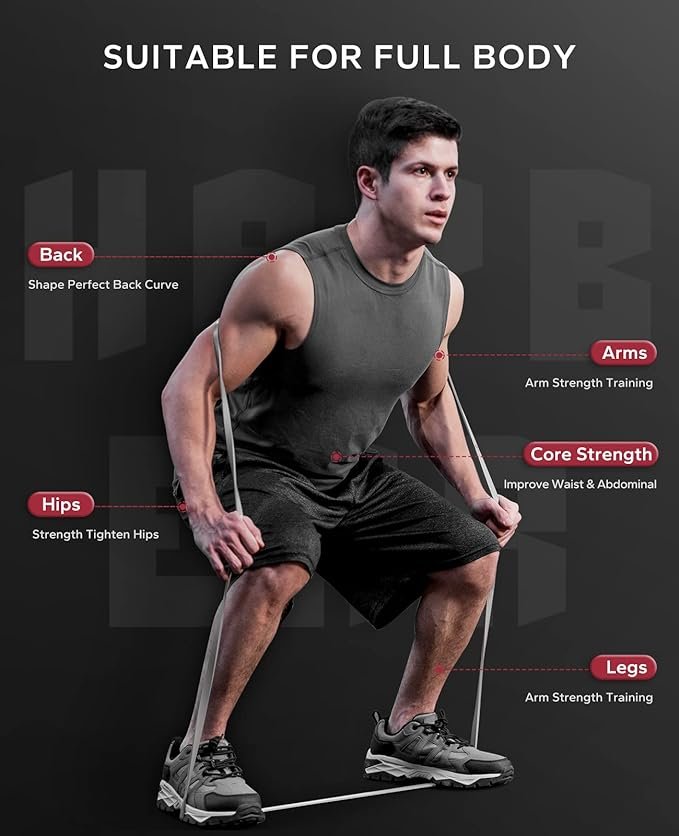Pull Up Assist

Pull Up Assistance Bands Best Long Power Workout Rubber
Pull Up Assistance Bands, HAPBEAR Resistance Band Set of 5, Long Power Workout Rubber Bands with Door Anchor, Strength Heavy Duty Exercise Bands for Powerlifting Stretching Fitness Training
Resistance Levels
Resistance Levels
Resistance levels refer to the amount of force or difficulty encountered when performing exercises using resistance bands, such as pull up assistance bands. These bands are versatile tools that provide varying levels of resistance, making them suitable for users of all fitness levels, from beginners to advanced athletes.

Types of Resistance Levels
- Light Resistance Bands: These bands offer the least amount of resistance and are ideal for beginners or individuals recovering from injuries. They are commonly used for rehabilitation exercises, stretching, and light muscle toning.
- Medium Resistance Bands: Providing moderate resistance, these bands are suitable for general strength training, toning muscles, and enhancing flexibility. They are often used in exercises targeting larger muscle groups like the legs, back, and chest.
- Heavy Resistance Bands: Designed for advanced strength training, heavy resistance bands offer significant resistance and are useful for building muscle mass and strength. They are commonly used for exercises such as squats, deadlifts, and pull-ups.
Using Pull Up Assistance Bands
Pull up assistance bands are a specific type of resistance band designed to assist with pull-up exercises by offsetting a portion of your body weight. They are available in different resistance levels to accommodate various strength levels and fitness goals. Here’s how they work:
- Assisted Pull-Ups: Attach the band to a pull-up bar and place your foot or knee in the loop or band. The band reduces the amount of weight you have to lift, making pull-ups easier to perform until you build enough strength to do unassisted pull-ups.
- Resistance for Strength Training: Apart from assisting with pull-ups, these bands can be used for a variety of strength training exercises such as bicep curls, shoulder presses, and chest presses. The resistance provided by the bands challenges your muscles throughout the entire range of motion, promoting muscle growth and strength gains.

Material Quality
Material Quality
The material quality of pull up assistance bands plays a crucial role in their effectiveness, durability, and safety during use. Understanding the materials used in manufacturing these bands helps users make informed decisions about their purchase and usage.
Types of Materials Used
- Natural Latex: Most pull up assistance bands are made from natural latex rubber due to its elasticity and durability. Latex bands offer varying levels of resistance and are commonly color-coded to indicate different resistance levels (e.g., red for heavy resistance, green for medium, etc.). Natural latex bands are preferred for their stretchability and ability to maintain shape over time.
- Synthetic Rubber: Some bands are made from synthetic rubber materials, which can offer similar elasticity and durability as natural latex. These bands may be preferred by individuals with latex allergies or sensitivities.
Characteristics of High-Quality Materials
- Elasticity: Quality bands should stretch smoothly and evenly without snapping or losing elasticity over time. This ensures consistent resistance during exercises.
- Durability: The material should be resistant to tears, abrasions, and wear, ensuring longevity even with frequent use.
- Safety: High-quality bands are less likely to break unexpectedly, reducing the risk of injury during exercises.
Benefits of Quality Materials
- Effective Workouts: Bands made from high-quality materials provide reliable resistance, allowing users to perform exercises effectively for muscle strengthening and toning.
- Longevity: Durable materials ensure bands withstand repeated stretching and use without losing their shape or effectiveness.
- Comfort: Quality bands often have smoother surfaces and edges, enhancing comfort during workouts and reducing skin irritation.

Price

Pros and coins
Pros and Cons of Pull Up Assistance Bands
Pull up assistance bands are popular tools for building strength and improving fitness, particularly for assisting with pull-up exercises. Understanding their advantages and potential drawbacks can help determine if they are suitable for your fitness goals.
Pros
- Assistance with Pull-Ups: The primary benefit of pull up assistance bands is their ability to help beginners or those lacking upper body strength perform pull-ups by reducing the amount of body weight they need to lift.
- Progressive Resistance: Bands come in various resistance levels, allowing for progressive strength training. As strength improves, users can switch to bands with less assistance or increase resistance for more challenging workouts.
- Versatility: Besides pull-ups, these bands can be used for a wide range of exercises targeting different muscle groups, including rows, presses, squats, and stretches, making them versatile additions to any workout routine.
- Portable and Affordable: They are lightweight and compact, making them easy to carry and store. Compared to bulky gym equipment, pull up assistance bands are affordable options for home workouts.
- Safety and Joint Support: The bands provide support during exercises, reducing the strain on joints and muscles compared to free weights or machines, which can help prevent injuries.
Cons
- Limited Overload: While bands offer resistance, they may not provide the same level of muscle overload as heavy weights or machines. This could limit maximal strength gains for advanced lifters.
- Learning Curve: Proper form and technique are crucial to maximize the benefits and avoid injury when using pull up assistance bands. Beginners may need guidance initially to use them effectively.
- Durability Concerns: Lower-quality bands can wear out over time, losing elasticity or even breaking with frequent use. Investing in bands made from durable materials is essential for long-term use.
- Band Slippage: Depending on the exercise and band placement, there may be instances of bands slipping or rolling, which can disrupt workouts and potentially cause discomfort.

